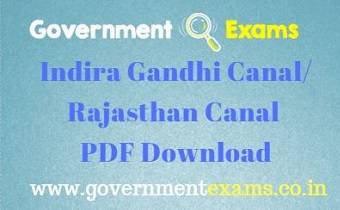Indira Gandhi Canal/ Rajasthan Canal:
Indira Gandhi Canal interesting facts, project details, benefits to farmers and how it revolutionized farming all given below. Check the details below or you can download PDF document of that Indira Gandhi Canal/ Rajasthan Canal below:
For Indira Gandhi Canal/ Rajasthan Canal notes PDF, check the link – Indira Gandhi Canal PDF.
Introduction:
- Indira Gandhi Canal is one of the largest canal systems located in Rajasthan, India.
- Previously called the Rajasthan Canal.
- Conceived by Kanwar Sain in 1948,
- It was launched on 31st March 1958.
- The canal originates at Harike barrage in Punjab and runs parallel to the Pakistan border at an average distance of 40 km in Thar Desert (Marusthali) of Rajasthan.
- The total planned length of the system is 9,060 km catering to the irrigation needs of a total culturable command area of 19.63 lakh hectares.
- Out of the total command area, about 70 percent was envisaged to be irrigated by the flow system and the rest by the lift system.
- The construction work is of two stages: Stage-I and Stage-II
Stage-I:
The command area of Stage-I lies in Ganganagar, Hanumangarh and northern part of Bikaner districts. It has a gently undulating topography and its culturable command area is 5.53 lakh hectares.
Stage-II:
The command area of Stage-II is spread over Bikaner, Jaisalmer, Barmer, Jodhpur, Nagaur and Churu districts covering an area of 14.10 lakh hectares. It comprises desert land dotted with shifting sand dunes and temperature soaring to 50oC in summers. In the lift canal, the water is lifted up to make it flow against the slope of the land. All the lift canals of the Indira Gandhi Canal system originate at the left bank of the main canal while all the canals on the right bank of the main canal are flow channels.
Interesting facts on Indira Gandhi Canal:
Irrigation in the Stage-I command area of the canal was introduced in the early 1960s. whereas, the command area of Stage-II began receiving irrigation in the mid-1980s. The introduction of canal irrigation in this dry land has transformed its ecology, economy, and society. It has influenced the environmental conditions of the region both positively as well as negatively. The availability of soil moisture for a longer period of time and various afforestation and pasture development programs under CAD have resulted in greening the land. This has also helped in reducing wind erosion and siltation of canal systems. But the intensive irrigation and excessive use of water have led to the emergence of twin environmental problems of waterlogging and soil salinity.
The introduction of canal irrigation has brought about a perceptible transformation in the agricultural economy of the region. Soil moisture has been a limiting factor in the successful growth of crops in this area. The spread of canal irrigation has led to an increase in cultivated area and intensity of cropping. The Traditional crops are sown are gram, bajra, and jowar have been replaced by wheat, cotton, groundnut, and rice. This is the result of intensive irrigation. This intensive irrigation, no doubt, initially has led to a tremendous increase in agricultural and livestock production. This has also caused waterlogging and soil salinity, and thus, in the long run, it hampers the sustainability of agriculture.
Rajasthan Canal Notes PDF, check the link – Indira Gandhi Canal PDF.

